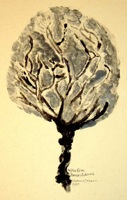Difference between revisions of "Placenta"
m (Text replacement - "http://" to "https://") |
|||
| Line 3: | Line 3: | ||
==Etymology== | ==Etymology== | ||
New Latin, from [[Latin]], flat cake, from [[Greek]] plakoenta, accusative of plakoeis, from plak-, plax flat [[surface]] | New Latin, from [[Latin]], flat cake, from [[Greek]] plakoenta, accusative of plakoeis, from plak-, plax flat [[surface]] | ||
| − | *Date: [ | + | *Date: [https://www.wikipedia.org/wiki/17th_Century 1691] |
==Definitions== | ==Definitions== | ||
*1 : the vascular organ in [[mammals]] except monotremes and marsupials that unites the [[fetus]] to the maternal [[uterus]] and mediates its [[metabolism|metabolic]] exchanges through a more or less [[intimate]] [[association]] of uterine mucosal with chorionic and usually allantoic tissues; also : an [[analogous]] organ in another [[animal]] | *1 : the vascular organ in [[mammals]] except monotremes and marsupials that unites the [[fetus]] to the maternal [[uterus]] and mediates its [[metabolism|metabolic]] exchanges through a more or less [[intimate]] [[association]] of uterine mucosal with chorionic and usually allantoic tissues; also : an [[analogous]] organ in another [[animal]] | ||
*2 : a sporangium-bearing [[surface]]; especially : the part of the carpel bearing ovules | *2 : a sporangium-bearing [[surface]]; especially : the part of the carpel bearing ovules | ||
==Description== | ==Description== | ||
| − | The '''placenta''' is an organ that [[connects]] the [[developing]] [ | + | The '''placenta''' is an organ that [[connects]] the [[developing]] [https://en.wikipedia.org/wiki/Fetus fetus] to the uterine wall to allow nutrient uptake, waste elimination, and [[gas]] exchange via the mother's blood supply. Placentas are a defining characteristic of [https://en.wikipedia.org/wiki/Eutheria eutherian or "placental" mammals], but are also found in some snakes and lizards with varying levels of [[development]] up to [[mammalian]] levels. The [[word]] placenta comes from the [[Latin]] for cake, from [[Greek]] plakóenta/plakoúnta, accusative of plakóeis/plakoús – πλακόεις, πλακούς, "flat, slab-like", in [[reference]] to its round, flat [[appearance]] in [[humans]]. [https://en.wikipedia.org/wiki/Protheria Protherial] (egg-laying) and [https://en.wikipedia.org/wiki/Metatheria metatherial] (marsupial) mammals produce a choriovitelline placenta that, while [[connected]] to the uterine wall, provides nutrients mainly derived from the egg sac. The placenta [[develops]] from the same [[sperm]] and [[egg]] cells that form the [https://en.wikipedia.org/wiki/Fetus fetus], and [[functions]] as a fetomaternal organ with two components, the fetal part (Chorion frondosum), and the maternal part (Decidua basalis).[https://en.wikipedia.org/wiki/Placenta] |
[[Category: Biology]] | [[Category: Biology]] | ||
Latest revision as of 02:10, 13 December 2020
Etymology
New Latin, from Latin, flat cake, from Greek plakoenta, accusative of plakoeis, from plak-, plax flat surface
- Date: 1691
Definitions
- 1 : the vascular organ in mammals except monotremes and marsupials that unites the fetus to the maternal uterus and mediates its metabolic exchanges through a more or less intimate association of uterine mucosal with chorionic and usually allantoic tissues; also : an analogous organ in another animal
- 2 : a sporangium-bearing surface; especially : the part of the carpel bearing ovules
Description
The placenta is an organ that connects the developing fetus to the uterine wall to allow nutrient uptake, waste elimination, and gas exchange via the mother's blood supply. Placentas are a defining characteristic of eutherian or "placental" mammals, but are also found in some snakes and lizards with varying levels of development up to mammalian levels. The word placenta comes from the Latin for cake, from Greek plakóenta/plakoúnta, accusative of plakóeis/plakoús – πλακόεις, πλακούς, "flat, slab-like", in reference to its round, flat appearance in humans. Protherial (egg-laying) and metatherial (marsupial) mammals produce a choriovitelline placenta that, while connected to the uterine wall, provides nutrients mainly derived from the egg sac. The placenta develops from the same sperm and egg cells that form the fetus, and functions as a fetomaternal organ with two components, the fetal part (Chorion frondosum), and the maternal part (Decidua basalis).[1]
